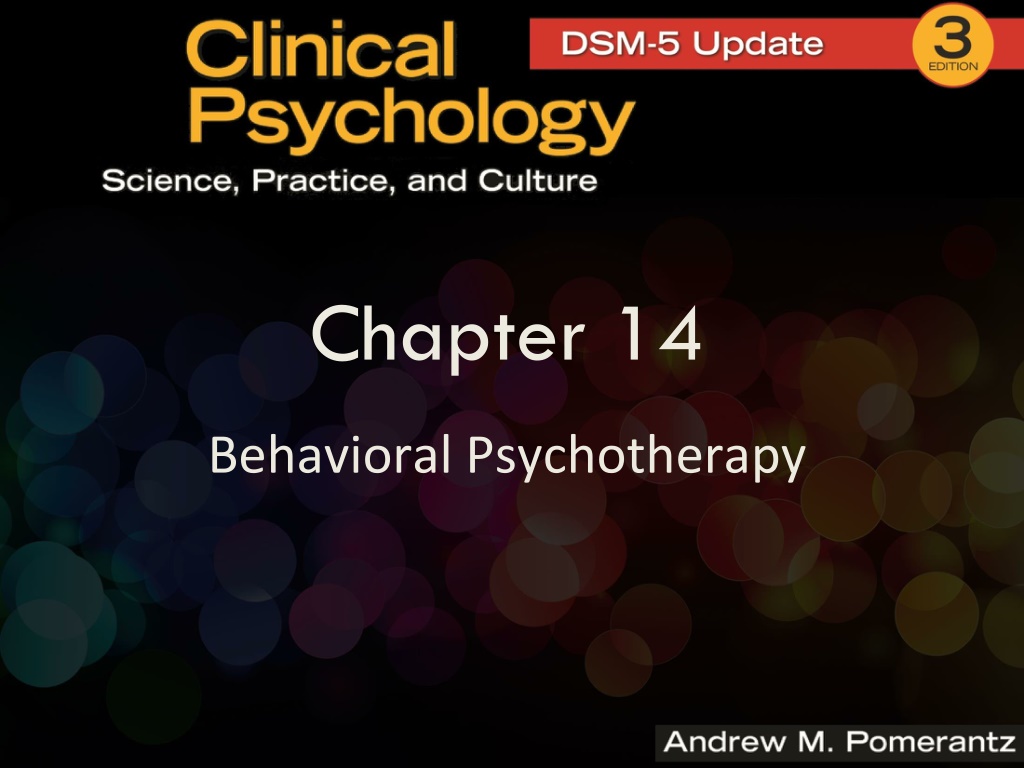
Understanding Behavioral Psychotherapy in Practice
Explore the origins and goals of behavioral psychotherapy, which emphasizes observable behavior change over internal processes. Learn how behavioral therapists apply the scientific method to assess, define, and address client behaviors effectively.
Download Presentation

Please find below an Image/Link to download the presentation.
The content on the website is provided AS IS for your information and personal use only. It may not be sold, licensed, or shared on other websites without obtaining consent from the author. If you encounter any issues during the download, it is possible that the publisher has removed the file from their server.
You are allowed to download the files provided on this website for personal or commercial use, subject to the condition that they are used lawfully. All files are the property of their respective owners.
The content on the website is provided AS IS for your information and personal use only. It may not be sold, licensed, or shared on other websites without obtaining consent from the author.
E N D
Presentation Transcript
Chapter 14 Behavioral Psychotherapy
Behavioral Psychotherapy Behavioral therapy represents a reaction against the lack of empiricism inherent in psychodynamic and humanistic approaches A reaction against mental processes that can t be precisely defined, directly observed, or scientifically tested
Origins of Behavioral Psychotherapy The clinical application of behavioral principles Roots of behaviorism include Ivan Pavlov s classical conditioning studies with dogs in Russia John Watson s efforts to bring classical conditioning to U. S. B. F. Skinner s and E. L. Thorndike s studies of operant conditioning
Goal of Behavioral Psychotherapy The primary goal of behavioral psychotherapy is observable behavior change No emphasis on internal, mental processes In contrast to previous approaches (e.g., psychodynamic and humanistic)
Goal of Behavioral Psychotherapy (cont.) Emphasis on empiricism Study of human behavior should be scientific Clinical methods should be scientifically evaluated via testable hypotheses and empirical data based on observable variables For example, baseline measures of problem behavior at outset; subsequent measures after some therapy
Goals of Behavioral Psychotherapy (cont.) Steps of the Scientific Method How Applied by Behavioral Therapists Assessing client behavior via observation, interview, or testing 1. Observing a phenomenon Defining a target behavior Establishing a baseline level of target behavior 2. Developing hypotheses to explain the Functional analysis of target behavior to determine the factors that phenomenon cause or influence it Establishing specific behavioral goals for treatment Planning interventions to alter behavior in preferred manner 3. Testing the hypotheses through Implement interventions as planned experimentation 4. Observing the outcome of the tests Collect data on changes in the target behavior Compare data collected during or after treatment to baseline data Compare data to goals 5. Revising the hypotheses Modify treatment plan as suggested by observed outcomes Restart scientific process with revised hypotheses
Goal of Behavioral Psychotherapy (cont.) Defining problems behaviorally Client behaviors are not symptoms of some underlying problem those behaviors are the problem Behavioral definitions make it easy to identify target behaviors and measure changes in therapy Clients own definitions can be very hard to assess or measure
Goal of Behavioral Psychotherapy (cont.) Measuring change observably Other kinds of therapists may measure change in clients in more inferential ways, but behavioral therapists use more unambiguous indications of progress Introspection is not an acceptable way to measure progress not directly observable
Two Types of Conditioning Classical conditioning Exemplified by Pavlov s dog studies UCS evokes UCR UCS and CS are paired (occur together) CS evokes CR CR is essentially the same as UCR, but in response to CS Generalization or discrimination to similar stimuli may take place
Two Types of Conditioning (cont.) Operant conditioning The organism operates on the environment, notices the consequences of the behavior, and incorporates those consequences into decisions regarding future behavior More active style of learning than classical conditioning Contingencies, or internal if then statements, are the product of operant conditioning
Techniques Based on Classical Conditioning Exposure therapy Systematic desensitization Assertiveness training
Techniques Based on Classical Conditioning (cont.) Exposure therapy Version of facing your fears Often used to treat anxiety disorders Client is repeatedly exposed to the feared object and the expected aversive outcome does not take place client no longer experiences the fear response
Techniques Based on Classical Conditioning (cont.) Exposure therapy (cont.) Exposure is typically gradual ( graded exposure), following an anxiety hierarchy Exposures can be imaginal or in vivo (real)
Techniques Based on Classical Conditioning (cont.) Exposure therapy (cont.) Exposure-plus-response-prevention is a particular form of exposure with empirical evidence in the treatment of OCD Anxiety hierarchy Stimulus Subjective Distress (0 = No Fear; 100 = Maximum Fear) Hearing a dog bark in another room 5 Standing within 20 feet of a dog on a leash 25 Standing within 5 feet of a dog on a leash 45 Petting a dog for 1 second 65 Petting a dog continuously for 10 seconds 75 Petting a dog continuously for 3 minutes 95
Techniques Based on Classical Conditioning (cont.) Systematic desensitization Often used for phobias and other anxiety disorders Similar to exposure therapy, but relaxation training is included Relaxation is incompatible with anxiety Counterconditioning occurs when relaxation response replaces anxiety response
Techniques Based on Classical Conditioning (cont.) Assertiveness training A specific application of classical conditioning that targets clients social anxieties Benefits people whose timidity negatively influences their lives Includes elements of exposure and systematic desensitization Facing interpersonal fears Includes direct instructions, modeling, rehearsal, and homework
Techniques Based on Operant Conditioning Contingency management Extinction Token economies Shaping Behavioral activation Observational learning (or modeling)
Techniques Based on Operant Conditioning (cont.) Contingency management Powerful way to change behavior change the contingencies controlling it If consequences change, behavior changes Reinforcement and punishment should be identified and altered as needed Reinforcement is typically preferred over punishment Aversion therapy is one type based on punishment of unwanted behavior
Techniques Based on Operant Conditioning (cont.) Extinction Removal of an expected reinforcement that results in decreased frequency of a behavior Effective way to decrease unwanted behaviors Initially, can cause extinction burst (an increase in unwanted behavior), but ultimately, if reinforcement is still withheld, decrease will occur
Techniques Based on Operant Conditioning (cont.) Token economies Setting in which clients earn tokens for participating in predetermined target behaviors Tokens can be traded for reinforcements Most feasible in sites where behavior is continuously monitored e.g., Inpatient unit, correctional facility
Techniques Based on Operant Conditioning (cont.) Shaping Reinforcing successive approximations of the target behavior Reward each baby step toward the desired behavior Best for changing behaviors that are complex, challenging, or novel for client
Techniques Based on Operant Conditioning (cont.) Behavioral activation Based on simple idea that depressed people lack positive reinforcement Goal is to increase frequency of positively reinforcing behaviors Structured daily routine including rewarding behaviors (recalled from non-depressed time) May have classical conditioning components too
Techniques Based on Operant Conditioning (cont.) Observational learning (or modeling) Learning from the contingencies applied to other people Client observes demonstration of desired behavior and its consequences client given chances to imitate it Both imitation and vicarious learning can occur Certain qualities of the model influence effectiveness of observational learning For example, similarity to client increases learning
Alternatives to Behavior Therapy Behavioral consultation Indirect way for a behavior therapist to modify a client s behavior Three parties involved: the client, the consultee, and the consultant (therapist) Consultee spends significant time in natural setting with client e.g., Parent, caretaker, manager
Alternatives to Behavior Therapy (cont.) Parent training Specific form of behavioral consultation Parents seek help with problematic behaviors of their children Teacher training Specific form of behavioral consultation Teachers seek help with problematic behaviors of their students
How Well Does Behavioral Therapy Work? Behavioral therapies have a significant amount of empirical support, especially in comparison to most other forms of therapy Especially for anxiety disorders, depression, and children s behavior disorders May also be most empirically testable forms of therapy






















